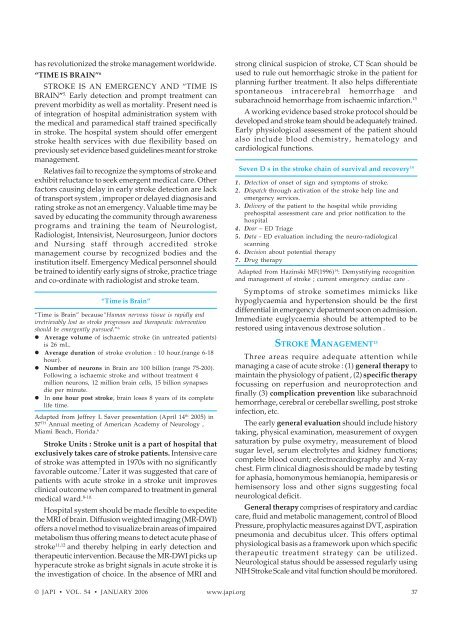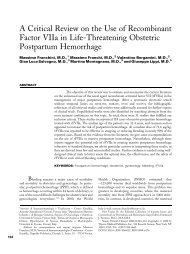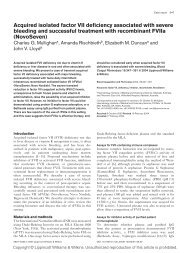Comprehensive Stroke Care : An Overview - ResearchGate
Comprehensive Stroke Care : An Overview - ResearchGate
Comprehensive Stroke Care : An Overview - ResearchGate
You also want an ePaper? Increase the reach of your titles
YUMPU automatically turns print PDFs into web optimized ePapers that Google loves.
has revolutionized the stroke management worldwide.<br />
“TIME IS BRAIN” 6<br />
STROKE IS AN EMERGENCY AND “TIME IS<br />
BRAIN” 5. Early detection and prompt treatment can<br />
prevent morbidity as well as mortality. Present need is<br />
of integration of hospital administration system with<br />
the medical and paramedical staff trained specifically<br />
in stroke. The hospital system should offer emergent<br />
stroke health services with due flexibility based on<br />
previously set evidence based guidelines meant for stroke<br />
management.<br />
Relatives fail to recognize the symptoms of stroke and<br />
exhibit reluctance to seek emergent medical care. Other<br />
factors causing delay in early stroke detection are lack<br />
of transport system , improper or delayed diagnosis and<br />
rating stroke as not an emergency. Valuable time may be<br />
saved by educating the community through awareness<br />
programs and training the team of Neurologist,<br />
Radiologist, Intensivist, Neurosurgeon, Junior doctors<br />
and Nursing staff through accredited stroke<br />
management course by recognized bodies and the<br />
institution itself. Emergency Medical personnel should<br />
be trained to identify early signs of stroke, practice triage<br />
and co-ordinate with radiologist and stroke team.<br />
“Time is Brain”<br />
“Time is Brain” because“Human nervous tissue is rapidly and<br />
irretrievably lost as stroke progresses and therapeutic intervention<br />
should be emergently pursued.” 6<br />
Average volume of ischaemic stroke (in untreated patients)<br />
is 26 mL.<br />
Average duration of stroke evolution : 10 hour.(range 6-18<br />
hour).<br />
Number of neurons in Brain are 100 billion (range 75-200).<br />
Following a ischaemic stroke and without treatment 4<br />
million neurons, 12 million brain cells, 15 billion synapses<br />
die per minute.<br />
In one hour post stroke, brain loses 8 years of its complete<br />
life time.<br />
Adapted from Jeffrey L Saver presentation (April 14 th 2005) in<br />
57 TH <strong>An</strong>nual meeting of American Academy of Neurology ,<br />
Miami Beach, Florida. 6<br />
<strong>Stroke</strong> Units : <strong>Stroke</strong> unit is a part of hospital that<br />
exclusively takes care of stroke patients. Intensive care<br />
of stroke was attempted in 1970s with no significantly<br />
favorable outcome. 7 Later it was suggested that care of<br />
patients with acute stroke in a stroke unit improves<br />
clinical outcome when compared to treatment in general<br />
medical ward. 8-10.<br />
Hospital system should be made flexible to expedite<br />
the MRI of brain. Diffusion weighted imaging (MR-DWI)<br />
offers a novel method to visualize brain areas of impaired<br />
metabolism thus offering means to detect acute phase of<br />
stroke 11,12 and thereby helping in early detection and<br />
therapeutic intervention. Because the MR-DWI picks up<br />
hyperacute stroke as bright signals in acute stroke it is<br />
the investigation of choice. In the absence of MRI and<br />
strong clinical suspicion of stroke, CT Scan should be<br />
used to rule out hemorrhagic stroke in the patient for<br />
planning further treatment. It also helps differentiate<br />
spontaneous intracerebral hemorrhage and<br />
subarachnoid hemorrhage from ischaemic infarction. 13<br />
A working evidence based stroke protocol should be<br />
developed and stroke team should be adequately trained.<br />
Early physiological assessment of the patient should<br />
also include blood chemistry, hematology and<br />
cardiological functions.<br />
Seven D s in the stroke chain of survival and recovery 14<br />
1. Detection of onset of sign and symptoms of stroke.<br />
2. Dispatch through activation of the stroke help line and<br />
emergency services.<br />
3. Delivery of the patient to the hospital while providing<br />
prehospital assessment care and prior notification to the<br />
hospital<br />
4. Door – ED Triage<br />
5. Data - ED evaluation including the neuro-radiological<br />
scanning<br />
6. Decision about potential therapy<br />
7. Drug therapy<br />
Adapted from Hazinski MF(1996) 14 : Demystifying recognition<br />
and management of stroke ; current emergency cardiac care .<br />
Symptoms of stroke sometimes mimicks like<br />
hypoglycaemia and hypertension should be the first<br />
differential in emergency department soon on admission.<br />
Immediate euglycaemia should be attempted to be<br />
restored using intavenous dextrose solution .<br />
STROKE MANAGEMENT 13<br />
Three areas require adequate attention while<br />
managing a case of acute stroke : (1) general therapy to<br />
maintain the physiology of patient , (2) specific therapy<br />
focussing on reperfusion and neuroprotection and<br />
finally (3) complication prevention like subarachnoid<br />
hemorrhage, cerebral or cerebellar swelling, post stroke<br />
infection, etc.<br />
The early general evaluation should include history<br />
taking, physical examination, measurement of oxygen<br />
saturation by pulse oxymetry, measurement of blood<br />
sugar level, serum electrolytes and kidney functions;<br />
complete blood count; electrocardiography and X-ray<br />
chest. Firm clinical diagnosis should be made by testing<br />
for aphasia, homonymous hemianopia, hemiparesis or<br />
hemisensory loss and other signs suggesting focal<br />
neurological deficit.<br />
General therapy comprises of respiratory and cardiac<br />
care, fluid and metabolic management, control of Blood<br />
Pressure, prophylactic measures against DVT, aspiration<br />
pneumonia and decubitus ulcer. This offers optimal<br />
physiological basis as a framework upon which specific<br />
therapeutic treatment strategy can be utilized.<br />
Neurological status should be assessed regularly using<br />
NIH <strong>Stroke</strong> Scale and vital function should be monitored.<br />
© JAPI • VOL. 54 • JANUARY 2006 www.japi.org 37





